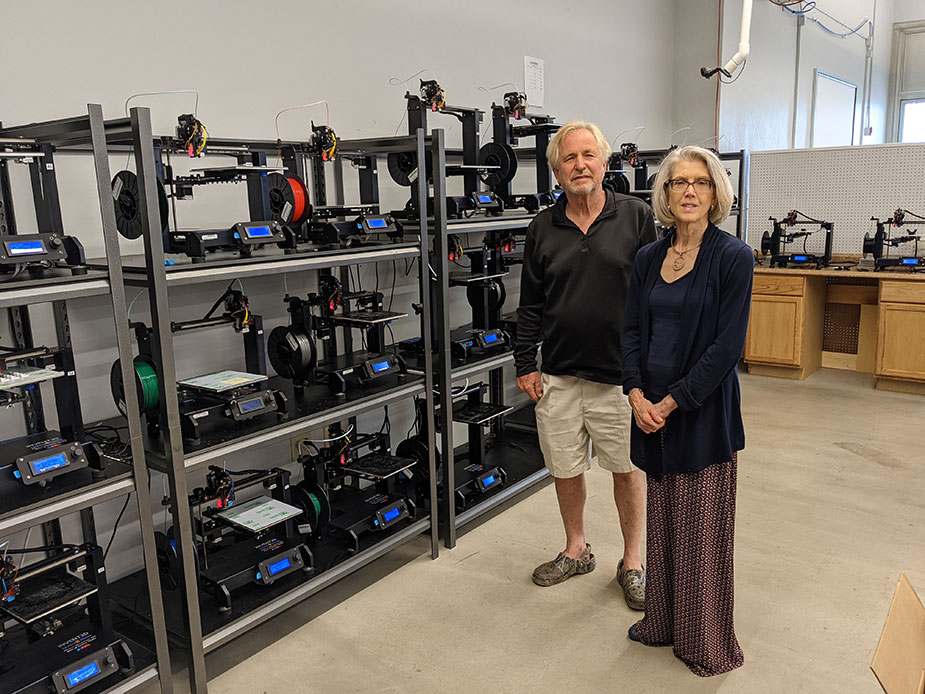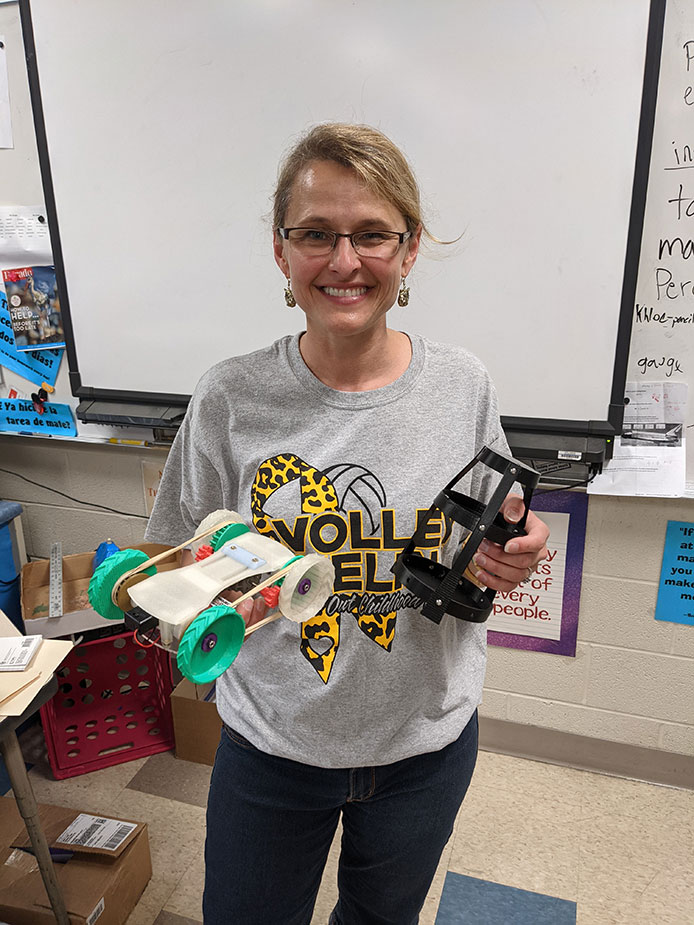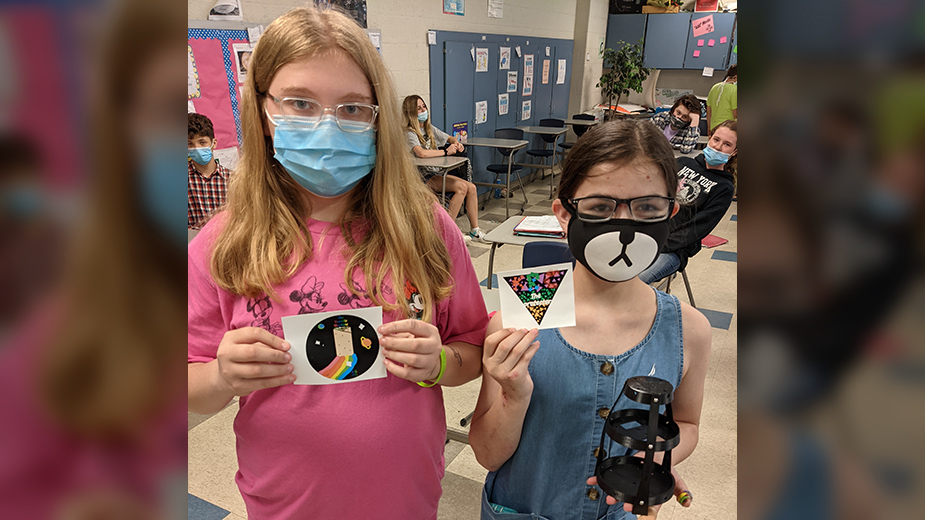LISBON, Ohio – Kyanne Pierson, a sixth grader in Lisbon schools, holds the frame of a model rocket, showing off the thought process and skills it took to design it on a 3D printer. She was among a small group that worked on the project, taking care to ensure it could hold the necessary equipment such as a fuel tank, plus the astronauts.
An egg was placed inside the vessel to test its durability, but the shell cracked the first time. Then, another team member put part of a plastic cup around the rocket ship. It held the craft together and protected the egg.
“My favorite part about it was seeing what worked and what didn’t,” said Pierson, whose group started the project this spring.
It’s part of a program throughout Columbiana County schools, funded in part by the Ohio Department of Education’s RemotEDx subgrants for nonprofit or community-based student learning and remote education partners.
Advanced Methods in Innovation was the recipient of the $140,000 grant from the state. It partners with Youngstown City School District and Columbiana County Educational Service Center, which provides services to the school districts of Columbiana, Leetonia, Lisbon, Salem, Crestview, East Liverpool, Beaver, Southern, United, Wellsville and East Palestine.
AMI started the pilot program this spring, says Executive Director Julie Michael Smith, in Columbiana County with 12 teachers and 869 students at six schools with instruction being delivered in-person, blended and completely remote.

AMI supplies the program with Invent2Make makerspace projects, manufactured by Vista AST, that empower students to create solutions to unique challenges. For these students, their makerspace is at the Columbiana County Career and Technical Center in Lisbon.
The project targets rural and urban students in grades five trough eight who are underserved and underrepresented in the STEM fields – science, technology, engineering and mathematics.
The county school system received a $1 million grant from the state for the three-year venture called Project Inspire. Housed at the Columbiana County Career and Technical Center, the program offers 3D printers, vinyl and laser cutters, and materials. The curriculum was provided by Vista AST.
Seventh-grader Ben Weber began his Inventor Cloud project at the beginning of the 2020-21 school year. The platform is intended to foster a student’s sense of collaboration, critical thinking and creativity.
Weber made a vehicle through computer-animated design and placed it in a rectangular box filled with sand and rocks to emulate the surface of the planet Mars.
The Lisbon-area student says the project piqued his interest in engineering. He now wants to take advanced classes in high school to prepare for his future career.
“I want to be an aeronautical engineer, so that requires a lot of innovation,” he says. “Computer-animated design really does help with that.”
Janet Lane has taught in the Lisbon Exempted Village Schools system for 23 years. She has been learning how to use systems like AutoCad, using Google, YouTube and other sites to expedite the learning process. Sometimes, she finds herself acting as a cheerleader for her students to ensure they do not give up on the process.
“I can’t prepare you for jobs that aren’t invented yet because by the time they graduate there’s going to be new stuff out,” Lane says. “What I can prepare them for is to be able to work as a team, solve problems and get an idea of whether they know how to use a 3D printer.
“They learn how to code in another class, so this gets them some of the real-life skills.”

The students are learning marketable skills that employers seek, says John Dilling, retired superintendent of the Columbiana County Educational Service Center and current consultant.
“I think just spurring their creativity will help them to think about job possibilities that might be out there in the future,” he adds.
These possibilities are not limited to STEM. Art teachers have been working with the program to design projects and different programs through the use of 3D printing, Dilling says.
“It’s been a great partnership with Inventor Cloud,” he says. “When this RemotEDx grant came out, one of the things that we were concerned about was the loss of STEM skills when students couldn’t have as much hands-on experience when they’re doing home instruction.”
Jack Scott, chairman of the board of AMI, was an executive officer at a corporation in California before returning to Youngstown.
Scott was in charge of engineers for a company earning $5 billion a year in major projects.
As he hired new engineers, it became clear that the educational system needed to change. For years, he says, the gatekeeper to engineering was mathematics, which is not most appropriate.
“The gatekeeper to STEM is your ability to solve a problem,” Scott says. “If you can solve a problem, you can be a good scientist, you can be a good engineer, you can be a good employer for anybody if you can solve a problem.
“Our educational system today doesn’t focus the kids on solving problems. The problems they solve they take home on a worksheet that has an answer. They’re not focused on problem solving where there is not an answer. Problem solving is where their first solutions are probably not going to work. We teach failure is bad, but failure should stand for the first attempt in learning. That’s what fail should stand for: first attempt in learning. That’s how you learn.”
Too many times, he says, children are afraid of failure, and he has seen it with the engineers he hired.
Engineers design, redesign and see things eventually evolve, he says and that is the nature of the profession.
“We start with the Wright Brothers plane,” he says. “Today we have self-guided autonomous drones. There’s a lot of failures in between there.”
Pictured: Morgan Gough, left, and Kyanne Pierson, right, hold up team stickers for their project. The students at David Anderson Junior High School in Lisbon took part in a program funded by the RemotEDx grant through the Ohio Department of Education and Advanced Methods in Innovation.
